It is understood that the number one cause of species decline worldwide is habitat loss. As habitats are altered and removed, fish and wildlife species adapt, move, or die. The planet has witnessed an overall decline in biodiversity in the last 50 years and many attribute this first to habitat change. Pensacola Bay is no different.
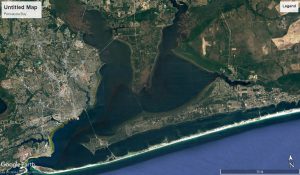
Image: Google Earth
Pensacola Bay covers a surface area of 144 mi2 and has a coastline of 552 miles. This system provides a variety of habitats for both terrestrial and aquatic vertebrate and invertebrate species. In the early history of human inhabitation in the bay area, not a lot of alteration was done, primarily because the technology to do so was not there. Our ancestors enjoyed a bay full of all sorts of creatures, many which helped sustain their lives. When you look at the bay you see a lot of water, and there is, but the bottom is covered by several habitat systems. As you might expect, much is covered in either sand or mud, which hosts their own ecosystems. But there are also seagrass meadows and reefs made from oysters that help stabilize the bottom, maintain water clarity, and provide habitat for numerous other species. It has been stated that at least 80% of our commercially and recreationally important seafood species spend at least part of their lives in these habitats.
However, as more humans moved in, more land was cleared for homes and businesses, streets and parking lots, hospitals and shopping centers, agriculture and timber interest. Historically rain fell on sandy soils and percolated down to the sand/gravel aquifer that supports our drinking water today. With the altering of the land, the vegetation that once trapped moving sand was now gone and that sand and mud flowed into nearby streams and eventually into the bay reducing water clarity and covering habitat. During the 20th century the paving of roads and parking lots, as well as the impervious surfaces of houses and buildings, created more “stormwater run-off” which led to engineered pipes and culverts that increased run-off into the bay to reduce flooding issues. The bay is becoming “murkier” since our arrival and this has changed, or destroyed, the estuarine habitats needed to support those commercial and recreational species we seek.
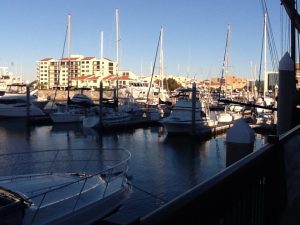
Photo: Rick O’Connor
The development was not restricted to the land. We needed deep water for boats to be able to move goods and for us to enjoy more recreational activities on the water. Pensacola Bay was lucky here in that it is a naturally deep-water bay. Most drowned river estuaries in the northern Gulf of Mexico are wide and shallow. Mobile Bay is 35 miles long, 10 miles wide, but much of it is not more than 10 feet deep. In order for shipping at the Port of Mobile to continue, dredging of the ship channel is a must, and dredging alters, or destroys, these benthic habitats. Pensacola Bay was naturally deep, something not missed by the Spanish colonists. But that cannot be said of the smaller bays and bayous that feed it. As people moved into this areas, dredging had to be done, and occasionally still does.
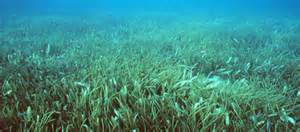
Photo: Virginia Sea Grant
Seagrass Meadows
Seagrasses are vascular plants that grow underwater. They are often referred to as submerged aquatic vegetation (SAV). As expected, these plants require clear water for sunlight to fuel their photosynthesis. It has been reported that at least 25% of the ambient sunlight hitting the surface of the bay must reach the bottom for many species to survive. Based on the 2016 EPA publication by Lewis, et.al., the bay had about 6,600 acres of submerged seagrass meadows at one time. The species varied depending on salinity. Eel grass (Vallisneria) and Widgeon grass (Ruppia) can tolerate lower salinities and are more common in the upper estuary. Shoal grass (Halodule) and Turtle grass (Thalassia) require higher salinities, at least 20‰, and are found in the lower bay. The EPA publication mentions that one acre of seagrass can support 40,000 fish and 5 million invertebrates, again – some commercially important to our economy.
As you might expect, the decrease in water clarity due to coastal and shoreline development as reduced the needed sunlight for photosynthesis and seagrass die-off has occurred. Since the 1950s there has been a reported 95% decline in seagrass- with current natural restoration, that number is 42%. All the major beds in Escambia and Pensacola Bays are now gone. A recent study suggests that today we have about 4000 acres left, much of this is in the lower portions of the estuary and those meadows seem to be stable.
Most efforts to restore seagrass by planting have failed. The Tampa Bay Estuary Program set a goal of restoring 80% of the seagrass they loss by reducing the stressors that caused the decline. They met this goal in 2015. What stressors are these?
We already mentioned sediment run-off decreasing water clarity, but water clarity has also been reduced by increased algal blooms fueled by increased fertilizers from both residential and agricultural sources. These can be reduced with better building and infrastructure building codes and BMP practices for gardeners and farmers. There are a variety of “green infrastructure” engineering methods designed to reduce the amount of run-off reaching the bay as well as the amount of sediment, fertilizers, and other chemicals within. There are several methods of conducting less fertilizer gardening, farming, and landscaping. You can contact your county extension office to learn more about these methods.
In addition to decreasing water clarity, run-off can contribute to decrease in overall salinity which can stress certain species of seagrasses. These green infrastructure plans can help reduce this problem. Dock, pier, and marina building has become more regulated in the sense of including seagrass impact planning in their permitting. Again, the existing seagrass meadows seem to be stable. A citizen science monitoring program overseen by the University of West Florida is currently monitoring our meadows. If interested in participating, contact your county extension office.
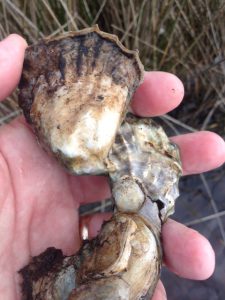
Oyster Reefs
Since the 1960s there has been a reported 72% decline in the oyster reefs of the Pensacola Bay System (from 631 to 471 acres). These are one of the more biological diverse systems in the bay area supporting a large variety of fish and invertebrate species.
The cause of decline is very similar to that of seagrass meadows. Increased sedimentation can literally bury oysters. Reef growth can respond to natural accretion of sediment but cannot with the large volumes entering the bay currently. Ironically, oysters are filter feeders and do an excellent job controlling high concentration algal blooms, but the reduction of oysters has the opposite effect. Freshwater inputs are good up to a point. Higher salinities are known to increase both predation and disease on oysters (as witnessed in Apalachicola Bay) and oyster reefs tend to be found in the upper portions of the estuary where salinities are low enough to curtail this. But excessive freshwater can be life threatening as well (as witnessed by a local off bottom cage oyster farm after the heavy rains of 2018 reduced salinity). So, there is a needed balance in salinities for oyster reefs to exist. Historically, upper portions of Pensacola Bay and much of Escambia and East Bay supported such reefs. Again, these are all but gone.
There is the issue of oyster harvesting. Oysters have been harvested from the bay since humans first arrived here. East Bay oysters in particular are popular in the seafood markets. With the impact of declining water quality on oyster reefs, harvesting did not help. Tonging is a more sustainable method of harvesting, but dredging has been used. During the Deepwater Horizon oil spill local harvesters were asked to remove as many live oysters as they could so as to not be “oiled”. The reefs have not recovered from this mass removal.
But restoration methods for oyster reefs are better understood, and more successful, than seagrass meadows. Recently the Nature Conservancy oversaw a year long process of developing an oyster restoration plan for the bay which included a variety of stakeholders including the harvesters. Issues currently being faced are continued water quality problems and the lack of suitable hard bottom for reefs to initiate. A common method of doing this is to collect shell from processors and restaurants. Once these were used for other projects, such as roads and building foundations. They are now left in large fields where they dry for several months before being dumped back to the bottom of the bay for new oyster to grow on. “Oyster Gardening” projects, where waterfront residents can grow oysters on lines hanging from their docks and then tossing them onto the new reef, can enhance such projects.
Though these methods are known, success locally has been mixed. In many cases the selection of restoration sites has not worked. They were either too close to freshwater sources, or in areas where oysters did not historically exist. Pensacola receives a lot of rainfall each year, about 60 inches, but recently there have been years of 90 inches or more. So, some restoration projects placed in potentially good locations have experienced low salinities and high mortality due to excessive rainfall run-off. There are currently several agencies, NGOs, and the new Pensacola-Perdido Bay Estuary Program looking into more effective oyster reef restoration.

Salt Marshes
In the more protected areas of the bay large fields of emergent grass exist – these are the salt marshes. Like oyster reefs, these systems seem to be more abundant in the norther portions of the bay. They do exist in the lower bay in areas where waves are small enough. There are a few on the barrier islands and, due to their protection from the wind, in the local bayous. But the vast majority are in the upper reaches of Escambia and Blackwater Bays.
Like the previous two systems, these emergent grass habitats support a large variety of estuarine creatures. Crabs, clams, mussels, snails, worms, fish, reptiles, and many species of shorebirds can be found here. They are excellent sediment traps, removing run-off sediment before it reaches the bay maintaining good water clarity for seagrass growth. Because of this much of the bottom of a marsh is muddy and mucky. A characteristic, along with the biting insect population, not highly valued by humans. But they do value the commercial and recreational fish and shellfish species that depend on these marshes.
Salt marshes are also quite resilient to storms and rising seas. Being grasses, they can bend with the wind and withstand high wind hurricanes (as witnessed in Louisiana during Hurricane Andrew). Salt marshes can slowly roll inland as sea level slowly rises thus not loosing valuable shoreline. That is as long as they do not encounter a barrier such as a neighborhood or road.
The salt marsh community is also very resilient. Being exposed during low tides to intense sun and dry conditions and then wet and salty conditions at high tide, these species are well prepared for drastic changes and can tolerate large swings in salinity.
The big issue for this habitat has been the interest of humans wanting to live on the water. Living on a marsh is not acceptable for many and so they have been dredged, filled, and altered in many ways. Much of the waterfront along our bayous have become lawns and seawalls. With this we have lost the natural sediment traps these habitats provided, decreasing water clarity within those bayous and the impacts that come with this, as well as the biological production of fisheries we also desire.
Restoration efforts for salt marsh are only now gaining popularity with the Living Shoreline programs. Most efforts in the bay area have been small projects, Project Greenshores being an exception, but all efforts are important. There has been an increased interest in this from private homeowners since Hurricane Sally. Waterfront homeowners are concerned about the loss of property and some have been dissatisfied with the protection afforded by seawalls. The city, county, and state continue to implement projects in the bay area. Private homeowners are becoming interested and if you are – just contact the county extension office and we can help get you started.

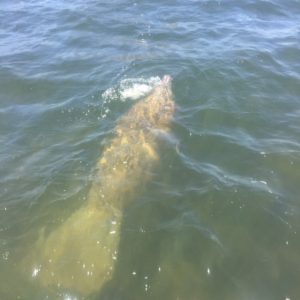
Photo: Marsha Stanton
Climate and Invasive Issues
The world is changing and so is Pensacola Bay. A couple of the changes involves the warming climate and the introduction of invasive species.
The warming climate is increasing sea level slowly. As mentioned, salt marshes can adapt to this change relatively easily – as long as they have space to “roll over”. But increased waterfront development may make this problematic and increased flooding during tropical storms will be in the future. Any and all waterfront planning should include sea level rise predictions in it. This increase in water level will be more problematic for oyster reef and seagrass restoration. Reef projects should include future predictions in their plan and placement as well.
Invasive species are plants and animals that are (1) nonnative to the area, (2) brought here by humans (whether intentionally or not), and (3) are causing an environmental or economic problem. For our estuarine habitats we are not seeing any large issues at the moment but there are a couple of Early Detection Rapid Response (EDRR) species on the horizon. Green mussels are as problematic as the famous zebra mussels further north. Currently known to be in the Tamp Bay area they could be transported here unintentionally and become a problem for us. They are tropical species, and thus may not be able to withstand our winters, but recent trends in winter temperatures suggest things are becoming milder, and so species like this could potentially be a problem. Oddly enough, the threat of the zebra mussel recently became an issue in Florida with the sale of “moss balls” at aquarium stores. They have been found to carry the young of this species.
Others we are watching are Asian Tiger Shrimp, Torpedograss, and recent reports of lionfish inside of the pass. Phragmites is not considered an invasive, the local variety is native to the Gulf coast, but is considered a nuisance and concern by many.
There are other tropical species that could be entering the bay that may or may not be invasive. Mangroves are dispersing further north naturally. Manatees and snook are now being reported. What impact, if any, these will have – and whether that impact is positive or negative – is yet to be seen.
There is much work to be done to restore the traditional estuarine habitats for the bay area. But there is also much interest in doing so. With a concentrated effort from local agencies, NGOs, and private citizens, we can do just that. The Escambia and Santa Rosa County Extension Offices both provide citizen science opportunities to assist with monitoring changes in these habitats over time. Contact us if you are interested.
References
Lewis, Michael, J. Taylor Kirschenfeld, and Traci Goodheart. Environmental Quality of the Pensacola Bay System: Retrospective Review for Future Resource Management and Rehabilitation. U.S. Environmental Protection Agency, Gulf Breeze, FL, EPA/600/R-16/169, 2016.
The Pensacola Bay Surface Water Improvement and Management Plan. 2017. Northwest Florida Water Management District.
 0
0
